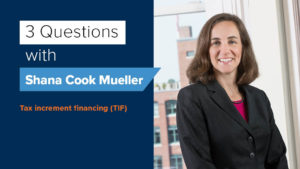3 Questions with Shana Cook Mueller: Strategic Use of Tax Increment Financing
 Bernstein Shur’s Shana Cook Mueller answers questions about tax increment financing (TIF).
Bernstein Shur’s Shana Cook Mueller answers questions about tax increment financing (TIF).
What is tax increment financing in ME?
Tax Increment Financing (TIF) is one of the few economic development tools available in ME to municipalities (and counties in the Unorganized Territory) and to businesses looking to build or expand a business location in ME. Tax Increment Financing can be used creatively to make projects successful, close funding gaps and finance public facilities and programs that support economic development. Specifically, TIFs allow municipalities to designate specific uses for property taxes generated over time from increased assessed value located in a particular area. Those specific uses can include payments to a developer or property owner under a “credit enhancement agreement” that is meant to make a particular development project successful. The potential uses of TIF revenues also include capital municipal facilities and projects that support economic development, grant or revolving loan programs for businesses, workforce development programs, environmental improvements projects related to economic development, adult day care and child care facilities and much more.
How does a TIF district get approved?
A ME TIF district is created and approved by a municipality or county (in the case of a TIF district located in an unorganized territory in ME). Specifically, a municipality must hold a public hearing and obtain legislative body approval before submitting its TIF application to the ME Department of Economic and Community Development for statutory compliance review (or in instances where a special affordable housing TIF district is designated, the ME State Housing Authority). Municipalities often work closely with developers when creating a TIF district around a specific development project. Municipalities have discretion to hold multiple meetings and hearings before the legislative body vote. This process can take some time and often involves a negotiated process with a developer or the municipality may create a TIF district with no developer involvement. The documentation required by statute and ME Department of Economic and Community Development rules can also take some time to prepare.
What important lessons have you learned in helping clients with TIFs?
Municipalities want to do the right thing by their constituents and developers often make the case that TIF assistance is a critical funding component of a desirable project. Consequently, property owners seeking credit enhancement agreements must be able to articulate the following about a credit enhancement agreement request: (1) How does the developer’s project fit into the overall comprehensive planning and other goals of the municipality? (2) What difference will the credit enhancement agreement make to the success of the project? (3) What are the benefits of the credit enhancement agreement to residents of the municipality? and (4) How will a TIF district impact the municipality financially?
To help answer that last question, it is worth mentioning the so-called tax shift benefit. For municipalities, there is a significant financial incentive to consider the TIF program as a way to fund economic development projects and programs. This is called the tax shift benefit. State subsidies and County taxes are calculated using formulas which include a municipality’s equalized assessed valuation (call the “state valuation”). In each of these formulas, as a municipality’s state valuation increases, its State subsidy amounts decrease and its County tax payment obligation increases. Importantly, any assessed value that is captured in a TIF district is sheltered or invisible to the state valuation, and therefore, with respect to value in a municipality that is captured within a TIF district, there is no tax shift loss. Another way of thinking about this is that for every new tax dollar paid to a municipality in property taxes, some percentage of that dollar goes to increased county taxes and decreased subsidies. This tax shift loss, however, does not occur with respect to TIF captured value. Depending upon the municipality, this can be a significant financial incentive for municipalities to use the TIF program when appropriate.
